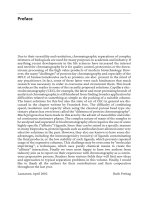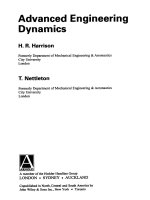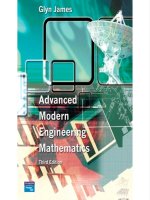Advanced Engineering Mathematics potx
Bạn đang xem bản rút gọn của tài liệu. Xem và tải ngay bản đầy đủ của tài liệu tại đây (209.6 KB, 18 trang )
Advanced
Engineering
Mathematics
fm.qxd 9/19/05 5:45 PM Page i
fm.qxd 9/19/05 5:45 PM Page ii
9TH EDITION
Advanced
Engineering
Mathematics
ERWIN KREYSZIG
Professor of Mathematics
Ohio State University
Columbus, Ohio
JOHN WILEY & SONS, INC.
fm.qxd 9/19/05 5:45 PM Page iii
Vice President and Publisher: Laurie Rosatone
Editorial Assistant: Daniel Grace
Associate Production Director: Lucille Buonocore
Senior Production Editor: Ken Santor
Media Editor: Stefanie Liebman
Cover Designer: Madelyn Lesure
Cover Photo: © John Sohm/Chromosohm/Photo Researchers
This book was set in Times Roman by GGS Information Services
and printed and bound by Von Hoffmann, Inc.
The cover was printed by Von Hoffmann, Inc.
This book is printed on acid-free paper.
Copyright © 2006 John Wiley & Sons, Inc. All rights reserved.
No part of this publication may be reproduced, stored in a retrieval system or transmitted in any
form or by any means, electronic, mechanical, photocopying, recording, scanning or otherwise,
except as permitted under Sections 107 or 108 of the 1976 United States Copyright Act, without
either the prior written permission of the Publisher, or authorization through payment of the
appropriate per-copy fee to the Copyright Clearance Center, 222 Rosewood Drive, Danvers, MA
01923, (508) 750-8400, fax (508) 750-4470. Requests to the Publisher for permission should be
addressed to the Permissions Department, John Wiley & Sons, Inc., 111 River Street, Hoboken, NJ
07030, (201) 748-6011, fax (201) 748-6008, E-Mail:
Kreyszig, Erwin.
Advanced engineering mathematics / Erwin Kreyszig.—9th ed.
p. cm.
Accompanied by instructor’s manual.
Includes bibliographical references and index.
ISBN 0-471-48885-2 (cloth : acid-free paper)
1. Mathematical physics. 2. Engineering mathematics. 1. Title.
ISBN-13: 978-0-471-48885-9
ISBN-10: 0-471-48885-2
Printed in the United States of America
10987654321
fm.qxd 9/29/05 1:15 PM Page iv
PREFACE
See also />Goal of the Book. Arrangement of Material
This new edition continues the tradition of providing instructors and students with a
comprehensive and up-to-date resource for teaching and learning engineering
mathematics, that is, applied mathematics for engineers and physicists, mathematicians
and computer scientists, as well as members of other disciplines. A course in elementary
calculus is the sole prerequisite.
The subject matter is arranged into seven parts A–G:
A Ordinary Differential Equations (ODEs) (Chaps. 1–6)
B Linear Algebra. Vector Calculus (Chaps. 7–9)
C Fourier Analysis. Partial Differential Equations (PDEs) (Chaps. 11–12)
D Complex Analysis (Chaps. 13–18)
E Numeric Analysis (Chaps. 19–21)
F Optimization, Graphs (Chaps. 22–23)
G Probability, Statistics (Chaps. 24–25).
This is followed by five appendices:
App. 1 References (ordered by parts)
App. 2 Answers to Odd-Numbered Problems
App. 3 Auxiliary Material (see also inside covers)
App. 4 Additional Proofs
App. 5 Tables of Functions.
This book has helped to pave the way for the present development of engineering
mathematics. By a modern approach to those areas A–G, this new edition will prepare
the student for the tasks of the present and of the future. The latter can be predicted to
some extent by a judicious look at the present trend. Among other features, this trend
shows the appearance of more complex production processes, more extreme physical
conditions (in space travel, high-speed communication, etc.), and new tasks in robotics
and communication systems (e.g., fiber optics and scan statistics on random graphs) and
elsewhere. This requires the refinement of existing methods and the creation of new ones.
It follows that students need solid knowledge of basic principles, methods, and results,
and a clear view of what engineering mathematics is all about, and that it requires
proficiency in all three phases of problem solving:
• Modeling, that is, translating a physical or other problem into a mathematical form,
into a mathematical model; this can be an algebraic equation, a differential equation,
a graph, or some other mathematical expression.
• Solving the model by selecting and applying a suitable mathematical method, often
requiring numeric work on a computer.
• Interpreting the mathematical result in physical or other terms to see what it
practically means and implies.
It would make no sense to overload students with all kinds of little things that might be of
occasional use. Instead they should recognize that mathematics rests on relatively few basic
concepts and involves powerful unifying principles. This should give them a firm grasp on
the interrelations among theory, computing, and (physical or other) experimentation.
v
fm.qxd 9/20/05 1:11 PM Page v
GUIDES AND MANUALS
Maple Computer Guide
Mathematica Computer Guide
Student Solutions Manual
Instructor’s Manual
vi Preface
PART A
Chaps. 1–6
Ordinary Differential Equations (ODEs)
Chaps. 1–4
Basic Material
Chap. 5 Chap. 6
Series Solutions Laplace Transforms
PART B
Chaps. 7–10
Linear Algebra. Vector Calculus
Chap. 7 Chap. 9
Matrices, Vector Differential
Linear Systems Calculus
Chap. 8 Chap. 10
Eigenvalue Problems Vector Integral Calculus
PARTS AND CHAPTERS OF THE BOOK
PART C
Chaps. 11–12
Fourier Analysis. Partial Differential
Equations (PDEs)
Chap. 11
Fourier Analysis
Chap. 12
Partial Differential Equations
PART D
Chaps. 13–18
Complex Analysis,
Potential Theory
Chaps. 13–17
Basic Material
Chap. 18
Potential Theory
PART E
Chaps. 19–21
Numeric Analysis
Chap. 19 Chap. 20 Chap. 21
Numerics in Numeric Numerics for
General Linear Algebra ODEs and PDEs
PART F
Chaps. 22–23
Optimization, Graphs
Chap. 22 Chap. 23
Linear Programming Graphs, Optimization
PART G
Chaps. 24–25
Probability, Statistics
Chap. 24
Data Analysis. Probability Theory
Chap. 25
Mathematical Statistics
fm.qxd 9/19/05 5:45 PM Page vi
General Features of the Book Include:
• Simplicity of examples, to make the book teachable—why choose complicated
examples when simple ones are as instructive or even better?
• Independence of chapters, to provide flexibility in tailoring courses to special needs.
• Self-contained presentation, except for a few clearly marked places where a proof
would exceed the level of the book and a reference is given instead.
• Modern standard notation, to help students with other courses, modern books, and
mathematical and engineering journals.
Many sections were rewritten in a more detailed fashion, to make it a simpler book. This
also resulted in a better balance between theory and applications.
Use of Computers
The presentation is adaptable to various levels of technology and use of a computer or
graphing calculator: very little or no use, medium use, or intensive use of a graphing
calculator or of an unspecified CAS (Computer Algebra System, Maple, Mathematica,
or Matlab being popular examples). In either case texts and problem sets form an entity
without gaps or jumps. And many problems can be solved by hand or with a computer
or both ways. (For software, see the beginnings of Part E on Numeric Analysis and Part G
on Probability and Statistics.)
More specifically, this new edition on the one hand gives more prominence to tasks
the computer cannot do, notably, modeling and interpreting results. On the other hand, it
includes CAS projects, CAS problems, and CAS experiments, which do require a
computer and show its power in solving problems that are difficult or impossible to access
otherwise. Here our goal is the combination of intelligent computer use with high-quality
mathematics. This has resulted in a change from a formula-centered teaching and learning
of engineering mathematics to a more quantitative, project-oriented, and visual approach.
CAS experiments also exhibit the computer as an instrument for observations and
experimentations that may become the beginnings of new research, for “proving” or
disproving conjectures, or for formalizing empirical relationships that are often quite useful
to the engineer as working guidelines. These changes will also help the student in
discovering the experimental aspect of modern applied mathematics.
Some routine and drill work is retained as a necessity for keeping firm contact with
the subject matter. In some of it the computer can (but must not) give the student a hand,
but there are plenty of problems that are more suitable for pencil-and-paper work.
Major Changes
1. New Problem Sets. Modern engineering mathematics is mostly teamwork. It usually
combines analytic work in the process of modeling and the use of computer algebra and
numerics in the process of solution, followed by critical evaluation of results. Our
problems—some straightforward, some more challenging, some “thinking problems” not
accessible by a CAS, some open-ended—reflect this modern situation with its increased
emphasis on qualitative methods and applications, and the problem sets take care of this
novel situation by including team projects, CAS projects, and writing projects. The latter
will also help the student in writing general reports, as they are required in engineering
work quite frequently.
2. Computer Experiments, using the computer as an instrument of “experimental
mathematics” for exploration and research (see also above). These are mostly open-ended
Preface vii
fm.qxd 9/19/05 5:45 PM Page vii
experiments, demonstrating the use of computers in experimentally finding results, which
may be provable afterward or may be valuable heuristic qualitative guidelines to the
engineer, in particular in complicated problems.
3. More on modeling and selecting methods, tasks that usually cannot be automated.
4. Student Solutions Manual and Study Guide enlarged, upon explicit requests
of the users. This Manual contains worked-out solutions to carefully selected odd-numbered
problems (to which App. 1 gives only the final answers) as well as general comments
and hints on studying the text and working further problems, including explanations on
the significance and character of concepts and methods in the various sections of the
book.
Further Changes, New Features
• Electric circuits moved entirely to Chap. 2, to avoid duplication and repetition
• Second-order ODEs and Higher Order ODEs placed into two separate chapters
(2 and 3)
• In Chap. 2, applications presented before variation of parameters
• Series solutions somewhat shortened, without changing the order of sections
• Material on Laplace transforms brought into a better logical order: partial fractions
used earlier in a more practical approach, unit step and Dirac’s delta put into separate
subsequent sections, differentiation and integration of transforms (not of functions!)
moved to a later section in favor of practically more important topics
• Second- and third-order determinants made into a separate section for reference
throughout the book
• Complex matrices made optional
• Three sections on curves and their application in mechanics combined in a single section
• First two sections on Fourier series combined to provide a better, more direct start
• Discrete and Fast Fourier Transforms included
• Conformal mapping presented in a separate chapter and enlarged
• Numeric analysis updated
• Backward Euler method included
• Stiffness of ODEs and systems discussed
• List of software (in Part E) updated; another list for statistics software added (in Part G)
• References updated, now including about 75 books published or reprinted after 1990
Suggestions for Courses: A Four-Semester Sequence
The material, when taken in sequence, is suitable for four consecutive semester courses,
meeting 3–4 hours a week:
1st Semester. ODEs (Chaps. 1–5 or 6)
2nd Semester. Linear Algebra. Vector Analysis (Chaps. 7–10)
3rd Semester. Complex Analysis (Chaps. 13–18)
4th Semester. Numeric Methods (Chaps. 19–21)
viii Preface
fm.qxd 9/19/05 5:45 PM Page viii
Suggestions for Independent One-Semester Courses
The book is also suitable for various independent one-semester courses meeting 3 hours
a week. For instance:
Introduction to ODEs (Chaps. 1–2, Sec. 21.1)
Laplace Transforms (Chap. 6)
Matrices and Linear Systems (Chaps. 7–8)
Vector Algebra and Calculus (Chaps. 9–10)
Fourier Series and PDEs (Chaps. 11–12, Secs. 21.4–21.7)
Introduction to Complex Analysis (Chaps. 13–17)
Numeric Analysis (Chaps. 19, 21)
Numeric Linear Algebra (Chap. 20)
Optimization (Chaps. 22–23)
Graphs and Combinatorial Optimization (Chap. 23)
Probability and Statistics (Chaps. 24–25)
Acknowledgments
I am indebted to many of my former teachers, colleagues, and students who helped me
directly or indirectly in preparing this book, in particular, the present edition. I profited
greatly from discussions with engineers, physicists, mathematicians, and computer
scientists, and from their written comments. I want to mention particularly Y. Antipov,
D. N. Buechler, S. L. Campbell, R. Carr, P. L. Chambre, V. F. Connolly, Z. Davis, J. Delany,
J. W. Dettman, D. Dicker, L. D. Drager, D. Ellis, W. Fox, A. Goriely, R. B. Guenther,
J. B. Handley, N. Harbertson, A. Hassen, V. W. Howe, H. Kuhn, G. Lamb, M. T. Lusk,
H. B. Mann, I. Marx, K. Millet, J. D. Moore, W. D. Munroe, A. Nadim, B. S. Ng, J. N.
Ong, Jr., D. Panagiotis, A. Plotkin, P. J. Pritchard, W. O. Ray, J. T. Scheick, L. F.
Shampine, H. A. Smith, J. Todd, H. Unz, A. L. Villone, H. J. Weiss, A. Wilansky, C. H.
Wilcox, H. Ya Fan, and A. D. Ziebur, all from the United States, Professors E. J.
Norminton and R. Vaillancourt from Canada, and Professors H. Florian and H. Unger
from Europe. I can offer here only an inadequate acknowledgment of my gratitude and
appreciation.
Special cordial thanks go to Privatdozent Dr. M. Kracht and to Mr. Herbert Kreyszig,
MBA, the coauthor of the Student Solutions Manual, who both checked the manuscript
in all details and made numerous suggestions for improvements and helped me proofread
the galley and page proofs.
Furthermore, I wish to thank John Wiley and Sons (see the list on p. iv) as well as GGS
Information Services, in particular Mr. K. Bradley and Mr. J. Nystrom, for their effective
cooperation and great care in preparing this new edition.
Suggestions of many readers worldwide were evaluated in preparing this edition.
Further comments and suggestions for improving the book will be gratefully received.
ERWIN KREYSZIG
Preface ix
fm.qxd 9/19/05 5:45 PM Page ix
fm.qxd 9/19/05 5:45 PM Page x
xi
C ONTENTS
PART A Ordinary Differential Equations (ODEs) 1
CHAPTER 1 First-Order ODEs 2
1.1 Basic Concepts. Modeling 2
1.2 Geometric Meaning of yЈ ϭ ƒ(x, y). Direction Fields 9
1.3 Separable ODEs. Modeling 12
1.4 Exact ODEs. Integrating Factors 19
1.5 Linear ODEs. Bernoulli Equation. Population Dynamics 26
1.6 Orthogonal Trajectories. Optional 35
1.7 Existence and Uniqueness of Solutions 37
Chapter 1 Review Questions and Problems 42
Summary of Chapter 1 43
CHAPTER 2 Second-Order Linear ODEs 45
2.1 Homogeneous Linear ODEs of Second Order 45
2.2 Homogeneous Linear ODEs with Constant Coefficients 53
2.3 Differential Operators. Optional 59
2.4 Modeling: Free Oscillations. (Mass–Spring System) 61
2.5 Euler–Cauchy Equations 69
2.6 Existence and Uniqueness of Solutions. Wronskian 73
2.7 Nonhomogeneous ODEs 78
2.8 Modeling: Forced Oscillations. Resonance 84
2.9 Modeling: Electric Circuits 91
2.10 Solution by Variation of Parameters 98
Chapter 2 Review Questions and Problems 102
Summary of Chapter 2 103
CHAPTER 3 Higher Order Linear ODEs 105
3.1 Homogeneous Linear ODEs 105
3.2 Homogeneous Linear ODEs with Constant Coefficients 111
3.3 Nonhomogeneous Linear ODEs 116
Chapter 3 Review Questions and Problems 122
Summary of Chapter 3 123
CHAPTER 4 Systems of ODEs. Phase Plane. Qualitative Methods 124
4.0 Basics of Matrices and Vectors 124
4.1 Systems of ODEs as Models 130
4.2 Basic Theory of Systems of ODEs 136
4.3 Constant-Coefficient Systems. Phase Plane Method 139
4.4 Criteria for Critical Points. Stability 147
4.5 Qualitative Methods for Nonlinear Systems 151
4.6 Nonhomogeneous Linear Systems of ODEs 159
Chapter 4 Review Questions and Problems 163
Summary of Chapter 4 164
CHAPTER 5 Series Solutions of ODEs. Special Functions 166
5.1 Power Series Method 167
5.2 Theory of the Power Series Method 170
fm.qxd 9/19/05 5:45 PM Page xi
5.3 Legendre’s Equation. Legendre Polynomials P
n
(x) 177
5.4 Frobenius Method 182
5.5 Bessel’s Equation. Bessel Functions J
(x) 189
5.6 Bessel Functions of the Second Kind Y
(x) 198
5.7 Sturm–Liouville Problems. Orthogonal Functions 203
5.8 Orthogonal Eigenfunction Expansions 210
Chapter 5 Review Questions and Problems 217
Summary of Chapter 5 218
CHAPTER 6 Laplace Transforms 220
6.1 Laplace Transform. Inverse Transform. Linearity. s-Shifting 221
6.2 Transforms of Derivatives and Integrals. ODEs 227
6.3 Unit Step Function. t-Shifting 233
6.4 Short Impulses. Dirac’s Delta Function. Partial Fractions 241
6.5 Convolution. Integral Equations 248
6.6 Differentiation and Integration of Transforms. 254
6.7 Systems of ODEs 258
6.8 Laplace Transform: General Formulas 264
6.9 Table of Laplace Transforms 265
Chapter 6 Review Questions and Problems 267
Summary of Chapter 6 269
PART B Linear Algebra. Vector Calculus 271
CHAPTER 7 Linear Algebra: Matrices, Vectors, Determinants.
Linear Systems 272
7.1 Matrices, Vectors: Addition and Scalar Multiplication 272
7.2 Matrix Multiplication 278
7.3 Linear Systems of Equations. Gauss Elimination 287
7.4 Linear Independence. Rank of a Matrix. Vector Space 296
7.5 Solutions of Linear Systems: Existence, Uniqueness 302
7.6 For Reference: Second- and Third-Order Determinants 306
7.7 Determinants. Cramer’s Rule 308
7.8 Inverse of a Matrix. Gauss–Jordan Elimination 315
7.9 Vector Spaces, Inner Product Spaces. Linear Transformations. Optional 323
Chapter 7 Review Questions and Problems 330
Summary of Chapter 7 331
CHAPTER 8
Linear Algebra: Matrix Eigenvalue Problems 333
8.1 Eigenvalues, Eigenvectors 334
8.2 Some Applications of Eigenvalue Problems 340
8.3 Symmetric, Skew-Symmetric, and Orthogonal Matrices 345
8.4 Eigenbases. Diagonalization. Quadratic Forms 349
8.5 Complex Matrices and Forms. Optional 356
Chapter 8 Review Questions and Problems 362
Summary of Chapter 8 363
xii Contents
fm.qxd 9/19/05 5:45 PM Page xii
CHAPTER 9 Vector Differential Calculus. Grad, Div, Curl 364
9.1 Vectors in 2-Space and 3-Space 364
9.2 Inner Product (Dot Product) 371
9.3 Vector Product (Cross Product) 377
9.4 Vector and Scalar Functions and Fields. Derivatives 384
9.5 Curves. Arc Length. Curvature. Torsion 389
9.6 Calculus Review: Functions of Several Variables. Optional 400
9.7 Gradient of a Scalar Field. Directional Derivative 403
9.8 Divergence of a Vector Field 410
9.9 Curl of a Vector Field 414
Chapter 9 Review Questions and Problems 416
Summary of Chapter 9 417
CHAPTER 10 Vector Integral Calculus. Integral Theorems 420
10.1 Line Integrals 420
10.2 Path Independence of Line Integrals 426
10.3 Calculus Review: Double Integrals. Optional 433
10.4 Green’s Theorem in the Plane 439
10.5 Surfaces for Surface Integrals 445
10.6 Surface Integrals 449
10.7 Triple Integrals. Divergence Theorem of Gauss 458
10.8 Further Applications of the Divergence Theorem 463
10.9 Stokes’s Theorem 468
Chapter 10 Review Questions and Problems 473
Summary of Chapter 10 474
PART C Fourier Analysis. Partial Differential Equations (PDEs) 477
CHAPTER 11 Fourier Series, Integrals, and Transforms 478
11.1 Fourier Series 478
11.2 Functions of Any Period p ϭ 2L 487
11.3 Even and Odd Functions. Half-Range Expansions 490
11.4 Complex Fourier Series. Optional 496
11.5 Forced Oscillations 499
11.6 Approximation by Trigonometric Polynomials 502
11.7 Fourier Integral 506
11.8 Fourier Cosine and Sine Transforms 513
11.9 Fourier Transform. Discrete and Fast Fourier Transforms 518
11.10 Tables of Transforms 529
Chapter 11 Review Questions and Problems 532
Summary of Chapter 11 533
CHAPTER 12 Partial Differential Equations (PDEs) 535
12.1 Basic Concepts 535
12.2 Modeling: Vibrating String, Wave Equation 538
12.3 Solution by Separating Variables. Use of Fourier Series 540
12.4 D’Alembert’s Solution of the Wave Equation. Characteristics 548
12.5 Heat Equation: Solution by Fourier Series 552
Contents xiii
fm.qxd 9/19/05 5:45 PM Page xiii
12.6 Heat Equation: Solution by Fourier Integrals and Transforms 562
12.7 Modeling: Membrane, Two-Dimensional Wave Equation 569
12.8 Rectangular Membrane. Double Fourier Series 571
12.9 Laplacian in Polar Coordinates. Circular Membrane. Fourier–Bessel Series 579
12.10 Laplace’s Equation in Cylindrical and Spherical Coordinates. Potential 587
12.11 Solution of PDEs by Laplace Transforms 594
Chapter 12 Review Questions and Problems 597
Summary of Chapter 12 598
PART D Complex Analysis 601
CHAPTER 13 Complex Numbers and Functions 602
13.1 Complex Numbers. Complex Plane 602
13.2 Polar Form of Complex Numbers. Powers and Roots 607
13.3 Derivative. Analytic Function 612
13.4 Cauchy–Riemann Equations. Laplace’s Equation 618
13.5 Exponential Function 623
13.6 Trigonometric and Hyperbolic Functions 626
13.7 Logarithm. General Power 630
Chapter 13 Review Questions and Problems 634
Summary of Chapter 13 635
CHAPTER 14 Complex Integration 637
14.1 Line Integral in the Complex Plane 637
14.2 Cauchy’s Integral Theorem 646
14.3 Cauchy’s Integral Formula 654
14.4 Derivatives of Analytic Functions 658
Chapter 14 Review Questions and Problems 662
Summary of Chapter 14 663
CHAPTER 15 Power Series, Taylor Series 664
15.1 Sequences, Series, Convergence Tests 664
15.2 Power Series 673
15.3 Functions Given by Power Series 678
15.4 Taylor and Maclaurin Series 683
15.5 Uniform Convergence. Optional 691
Chapter 15 Review Questions and Problems 698
Summary of Chapter 15 699
CHAPTER 16
Laurent Series. Residue Integration 701
16.1 Laurent Series 701
16.2 Singularities and Zeros. Infinity 707
16.3 Residue Integration Method 712
16.4 Residue Integration of Real Integrals 718
Chapter 16 Review Questions and Problems 726
Summary of Chapter 16 727
CHAPTER 17 Conformal Mapping 728
17.1 Geometry of Analytic Functions: Conformal Mapping 729
17.2 Linear Fractional Transformations 734
17.3 Special Linear Fractional Transformations 737
xiv Contents
fm.qxd 9/19/05 5:45 PM Page xiv
17.4 Conformal Mapping by Other Functions 742
17.5 Riemann Surfaces. Optional 746
Chapter 17 Review Questions and Problems 747
Summary of Chapter 17 748
CHAPTER 18 Complex Analysis and Potential Theory 749
18.1 Electrostatic Fields 750
18.2 Use of Conformal Mapping. Modeling 754
18.3 Heat Problems 757
18.4 Fluid Flow 761
18.5 Poisson’s Integral Formula for Potentials 768
18.6 General Properties of Harmonic Functions 771
Chapter 18 Review Questions and Problems 775
Summary of Chapter 18 776
PART E Numeric Analysis 777
Software 778
CHAPTER 19 Numerics in General 780
19.1 Introduction 780
19.2 Solution of Equations by Iteration 787
19.3 Interpolation 797
19.4 Spline Interpolation 810
19.5 Numeric Integration and Differentiation 817
Chapter 19 Review Questions and Problems 830
Summary of Chapter 19 831
CHAPTER 20 Numeric Linear Algebra 833
20.1 Linear Systems: Gauss Elimination 833
20.2 Linear Systems: LU-Factorization, Matrix Inversion 840
20.3 Linear Systems: Solution by Iteration 845
20.4 Linear Systems: Ill-Conditioning, Norms 851
20.5 Least Squares Method 859
20.6 Matrix Eigenvalue Problems: Introduction 863
20.7 Inclusion of Matrix Eigenvalues 866
20.8 Power Method for Eigenvalues 872
20.9 Tridiagonalization and QR-Factorization 875
Chapter 20 Review Questions and Problems 883
Summary of Chapter 20 884
CHAPTER 21 Numerics for ODEs and PDEs 886
21.1 Methods for First-Order ODEs 886
21.2 Multistep Methods 898
21.3 Methods for Systems and Higher Order ODEs 902
21.4 Methods for Elliptic PDEs 909
21.5 Neumann and Mixed Problems. Irregular Boundary 917
21.6 Methods for Parabolic PDEs 922
21.7 Method for Hyperbolic PDEs 928
Chapter 21 Review Questions and Problems 930
Summary of Chapter 21 932
Contents xv
fm.qxd 9/19/05 5:45 PM Page xv
PART F Optimization, Graphs 935
CHAPTER 22 Unconstrained Optimization. Linear Programming 936
22.1 Basic Concepts. Unconstrained Optimization 936
22.2 Linear Programming 939
22.3 Simplex Method 944
22.4 Simplex Method: Difficulties 947
Chapter 22 Review Questions and Problems 952
Summary of Chapter 22 953
CHAPTER 23 Graphs. Combinatorial Optimization 954
23.1 Graphs and Digraphs 954
23.2 Shortest Path Problems. Complexity 959
23.3 Bellman’s Principle. Dijkstra’s Algorithm 963
23.4 Shortest Spanning Trees: Greedy Algorithm 966
23.5 Shortest Spanning Trees: Prim’s Algorithm 970
23.6 Flows in Networks 973
23.7 Maximum Flow: Ford–Fulkerson Algorithm 979
23.8 Bipartite Graphs. Assignment Problems 982
Chapter 23 Review Questions and Problems 987
Summary of Chapter 23 989
PART G Probability, Statistics 991
CHAPTER 24 Data Analysis. Probability Theory 993
24.1 Data Representation. Average. Spread 993
24.2 Experiments, Outcomes, Events 997
24.3 Probability 1000
24.4 Permutations and Combinations 1006
24.5 Random Variables. Probability Distributions 1010
24.6 Mean and Variance of a Distribution 1016
24.7 Binomial, Poisson, and Hypergeometric Distributions 1020
24.8 Normal Distribution 1026
24.9 Distributions of Several Random Variables 1032
Chapter 24 Review Questions and Problems 1041
Summary of Chapter 24 1042
CHAPTER 25
Mathematical Statistics 1044
25.1 Introduction. Random Sampling 1044
25.2 Point Estimation of Parameters 1046
25.3 Confidence Intervals 1049
25.4 Testing Hypotheses. Decisions 1058
25.5 Quality Control 1068
25.6 Acceptance Sampling 1073
25.7 Goodness of Fit.
2
-Test 1076
25.8 Nonparametric Tests 1080
25.9 Regression. Fitting Straight Lines. Correlation 1083
Chapter 25 Review Questions and Problems 1092
Summary of Chapter 25 1093
xvi Contents
fm.qxd 9/22/05 11:52 AM Page xvi
APPENDIX 1 References A1
APPENDIX 2 Answers to Odd-Numbered Problems A4
APPENDIX 3 Auxiliary Material A60
A3.1 Formulas for Special Functions A60
A3.2 Partial Derivatives A66
A3.3 Sequences and Series A69
A3.4 Grad, Div, Curl, ٌ
2
in Curvilinear Coordinates A71
APPENDIX 4 Additional Proofs A74
APPENDIX 5
Tables A94
PHOTO CREDITS P1
INDEX I1
Contents xvii
fm.qxd 9/19/05 5:45 PM Page xvii
fm.qxd 9/19/05 5:45 PM Page xviii









